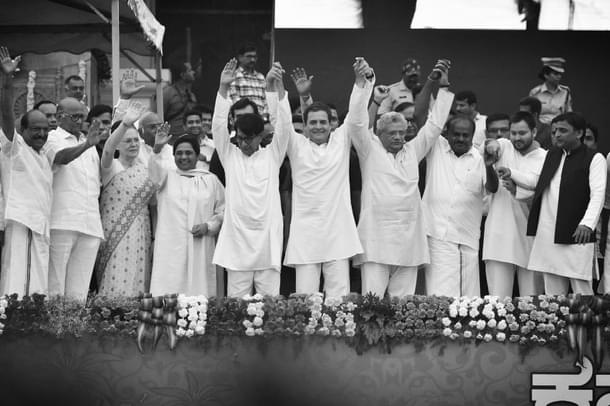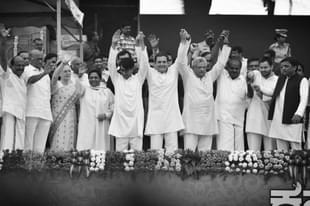Politics
Greater The Opposition Unity, Stronger The Growth Of BJP: Will Maharashtra Follow Karnataka And UP?
Praveen Patil
Nov 27, 2019, 03:54 PM | Updated 03:53 PM IST
Save & read from anywhere!
Bookmark stories for easy access on any device or the Swarajya app.


The political math of today’s India is at a unique position in history. Very few people can recognise this new beast, let alone comprehend it fully.
Let me try and explain this new mathematical paradigm using some simple voting numbers.
In the 2019 parliamentary elections, the Bharatiya Janata Party (BJP) secured 1.8 crore (18 million) votes in Karnataka, a quantum jump of nearly 50 lakh (5 million) votes as compared to either the 2014 parliamentary elections or the 2018 assembly elections.
Similarly, in the 80 parliamentary seats of Uttar Pradesh, BJP accrued a total of 4.38 crore (43.8 million) votes, again a quantum leap of nearly 1 crore (10 million) votes from the 2014 elections.
In both Karnataka and Uttar Pradesh, the BJP had done exceedingly well in the 2014 elections, so this new leap in 2019 came about from a high base and not a low base.
In both these states, BJP secured 50 per cent or more vote-share in the 2019 elections which meant that at least 1 out of every 2 voters voted saffron.
Incidentally, both Karnataka and Uttar Pradesh had witnessed a massive realignment in the opposition political space.
Congress and Janta Dal (Secular) (JD(S)), erstwhile arch-rivals in Karnataka, molded a formidable alliance. Similarly, the Samajwadi Party (SP) and the Bahujan Samaj Party (BSP), longtime political opponents in UP, had also joined hands (along with the Rashtriya Lok Dal in western parts of the state) with the express intention of defeating BJP and Modi.
As it turned out, these realignments, instead of halting the BJP, gave it greater political capital in the elections.
It is a fascinating aspect of this era of saffron political hegemony in India.
During the post-independence Congress era, the Index of Opposition Unity (IOU) was the most commonly deployed mathematical tool to measure the opposition’s ability to trump the Grand Old Party.
Today IOU has been turned on its head, for the new political mantra is – greater the opposition’s unity, stronger the growth of BJP.
The politics of Maharashtra too has not remained untouched by this newly formulated electoral math of India. The coming together of the Shiv Sena, the Nationalist Congress Party (NCP) and Congress has now vacated a deeper socio-political space for the BJP to grow in the state.
The media spectacle of Uddhav Thackeray, Sharad Pawar and the assorted Congress leaders taking oath in the name of Sonia Gandhi inside a five-star hotel has already sent a powerful message to the voters in the state. It is now just a matter of time before the undercurrent of demographic shift occurs in Maharashtra.
Shiv Sena’s presence in Maharashtra is largely limited to the Mumbai-Konkan belt. A significant section of the Sena support-base comes from ideological persuasions – the party’s governance track record is tardy at best, as symbolised by the various corporations that it controls, including the Brihanmumbai Municipal Corporation (BMC).
Whether it is the core Hindu voter or the agitational ‘Maratha Manoos’, both these groups will soon be disillusioned by the tight control of Congress over Sena’s passion politics. In fact, quite a few of the Sena voters are now angered by the party’s sudden shift to the left. The drift will begin sooner than expected.
Already Uddhav Thackeray has betrayed nerves. Unlike Bala Saheb, who wielded all his power from Matoshree, Uddhav has had to reach out to five-star hotels to cobble up a coalition.
Power in an organisation like that of the Sena comes with pure conviction. If that conviction weakens, the organisation itself begins to lose power.
We witnessed something similar in Karnataka after the 2018 state elections. The Gowda family there had been historically holding sway over the Vokkaliga community in the Old Mysore region. Yet, the Vokkaligas abandoned the JD(S) in 2019, despite the fact that their own man, Kumaraswamy, was the chief minister of the state.
As Uddhav begins his journey of compromises, Maharashtra will display the same political current as Karnataka did.
If that is the fate of the Shiv Sena, NCP’s situation is no better.
Contrary to all the narrative of how Sharad Pawar has revived the party in this election, the fact is that NCP’s vote-share has remained stagnant and regionally limited. If the Pawar-led outfit has still managed to win a decent haul of legislators, it is owing to just two factors:
One, the severe weather conditions of the state, drought followed by floods, which had created an undercurrent of anti-incumbency;
and second some serious strategic errors by the BJP (especially in some dozen odd seats where it lost despite being ahead before the elections).
Now that NCP will be forming a tri-partite government, the tug-of-war within will soon unfold in front of our eyes.
Maharashtra today offers the best possible scenario for the BJP to grow exponentially in a short period of time. This was a state where the party had stagnated between the 25 to 30 per cent mark (vote-share) for the last five years.
Now, unencumbered by any alliance pressures, the party can virtually double its presence in under five years as it has done in UP and other parts of India. This saffron growth will again be powered by the strength of the IOU (Index of Opposition Unity).
Let me elucidate this growth trajectory through a five-point political analysis.
1. When different opposition parties unite, it leads to political friction within that opens up substantial gaps for the BJP.
For instance, if Ajit Pawar is now sidelined, he will have little incentive to remain within this 3-party alliance – we also have definitive information that at least 21 NCP MLAs are deeply discomforted by this alliance and are just biding their time to strike. Such a disquiet will be true of legislators of all three parties in the alliance.
2. Historically, antagonistic political parties coming together means attrition of votes and not addition! This is the key to understand today’s political scenario.
For example, for a big chunk of SC voters in UP, phool (meaning lotus, the symbol of BJP) is the second-choice preference where haathi (elephant, the symbol of BSP) is absent and not cycle (SP symbol).
This holds true of Maharashtra too. A big chunk of Sena voters are intrinsically antagonistic to Congress/NCP and vice-versa.
BJP, being the sole opposition vote magnet will ensure that this attrition vote shifts en masse towards it (minus, of course, the Muslims who will begin to gravitate towards parties like AIMIM).
3. BJP is the only big tent Hindu party today that goes beyond caste arithmetic. For a large section of upper-castes, OBCs and SCs of Maharashtra, who will soon begin to feel the dominance of the Maratha lobby, turning into a deeper hue of saffron will be the only logical choice.
4. Regional disparities will aid BJP further as Uddhav is essentially a Mumbai leader with no connect to vast swaths of the State. Since BMC elections are also due in two years and it is the one region where the Sena has to maintain its patronage network, the government will most likely be skewed towards Mumbai and surrounding areas.
Again, something similar happened in Karnataka between 2018 and 2019 when Kumaraswamy was seen as catering only to the Old Mysore region at the cost of the rest of the state.
5. BJP today is the largest political party with crores of party workers and strong network of volunteers spread far and wide. When in power, large parts of this political network turn dormant. It is only when the party is pushed to the wall that this network gets strongly activated.
This is the true strength of the party both on the ground as well as on social media which will now come to play in Maharashtra.
The leadership of BJP also has to realise the full import of the 2019 mandate and create cohesive political opportunities for the party to grow unilaterally, shunning alliances as far as possible.
For instance, had the party fought Maharashtra on its own, it stood a much better chance of reaching closer to the 150-seat mark in the state. Nearly 20 BJP rebels have also made it to the assembly, highlighting the mistake of an alliance with Shiv Sena.
(You will find a deeper analysis of various facets of India’s politics today, like the changing contours of IOU, in my upcoming book, 2019 The Election Story).
Analyst of Indian electoral politics and associated economics with a right-of-centre perspective.




